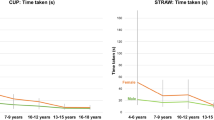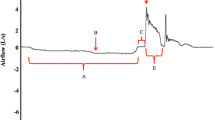Abstract
Dysphagia and resulting pulmonary sequelae are frequently observed in children with spastic cerebral palsy (SCP). However, physiological evidence regarding airway protective behaviors (specifically swallowing and cough function) in these children is sparse. The aim of this investigation was to quantify specific feeding, swallowing, and cough impairments in children with SCP compared to controls. Eleven children with SCP (mean age: 7 ± 2 years; GMFCS: I–V; MACS: I–V) and 10 age-matched controls participated. Clinical feeding and swallowing performance was evaluated with the dysphagia disorder survey (DDS) using standardized liquid, puree, and chewable solid consistencies. Suprahyoid muscle activity and respiratory–swallow patterns were assessed with simultaneous surface electromyography and respiratory inductance plethysmography as children swallowed the various consistencies. Voluntary cough airflow measures were also obtained. Nonparametric tests were used for group comparisons and correlational analyses. Compared to controls, children with SCP demonstrated more signs of clinical feeding and swallowing impairment (p < 0.0001, η2 = 0.771), heightened suprahyoid muscle activity for puree (p = 0.014, η2 = 0.305) and chewable solids (p = 0.001, η2 = 0.528), more frequent post-swallow inhalation across liquid (p = 0.005, η2 = 0.401), puree (p = 0.014, η2 = 0.304), and chewable solids (p = 0.035, η2 = 0.223), and lower cough volume acceleration (p = 0.019, η2 = 0.289). Post-swallow inhalation for chewable solids was correlated with the DDS Part 1 (rs = 0.734, p = 0.010), DDS Part 2 (rs = 0.610, p = 0.046) and the DDS Total scores (rs = 0.673, p = 0.023). This study is the first to provide evidence of specific physiological deficits of both swallowing and voluntary cough in children with SCP. Potential hypotheses explaining these deficits and implications for physiologically driven management are explored.




Similar content being viewed by others
References
Rosenbaum P, Paneth N, Leviton A, Goldstein M, Bax M, Damiano D, Dan B, Jacobsson B. A report: the definition and classification of cerebral palsy April 2006. Dev Med Child Neurol Suppl. 2007;109(suppl 109):8–14.
Kirby RS, Wingate MS, Braun KVN, Doernberg NS, Arneson CL, Benedict RE, Mulvihill B, Durkin MS, Fitzgerald RT, Maenner MJ, Patz JA, Yeargin-Allsopp M. Prevalence and functioning of children with cerebral palsy in four areas of the United States in 2006: a report from the Autism and Developmental Disabilities Monitoring Network. Res Dev Disabil. 2011;32(2):462–9.
Reid SM, Carlin JB, Reddihough DS. Distribution of motor types in cerebral palsy: how do registry data compare? Dev Child Neurol. 2011;53(3):233–8.
Himmelmann K, Uvebrant P. The panorama of cerebral palsy in Sweden. XI. Changing patterns in the birth‐year period 2003–2006. Acta Pediatr. 2014;103(6):618–24.
Arvedson JC, Rogers B, Buck G, Smart P, Msall M. Silent aspiration prominent in children with dysphagia. Int J Pediatr Otorhinolaryngol. 1994;28(2):173–81.
Mirrett PL, Riski JE, Glascott J, Johnson V. Videofluoroscopic assessment of dysphagia in children with severe spastic cerebral palsy. Dysphagia. 1994;9(3):174–9.
Rogers B, Arvedson J, Buck G, Smart P, Msall M. Characteristics of dysphagia in children with cerebral palsy. Dysphagia. 1994;9(1):69–73.
Calis EA, Veugelers R, Sheppard JJ, Tibboel D, Evenhuis HM, Penning C. Dysphagia in children with severe generalized cerebral palsy and intellectual disability. Dev Med Child Neurol. 2008;50(8):625–30.
Parkes J, Hill NAN, Platt MJ, Donnelly C. Oromotor dysfunction and communication impairments in children with cerebral palsy: a register study. Dev Med Child Neurol. 2010;52(12):1113–9.
Troche MS, Brandimore AE, Godoy J, Hegland KW. A framework for understanding shared substrates of airway protection. J Appl Oral Sci. 2014;22(4):251–60.
Santos M, Nogueira M. Infantile reflexes and their effects on dental caries and oral hygiene in cerebral palsy individuals. J Oral Rehabil. 2005;32(12):880–5.
Benfer KA, Weir KA, Bell KL, Ware RS, Davies PS, Boyd RN. Oral dysphagia and gross motor skills in children with cerebral palsy. Pediatr. 2013;131(5):e1553–62.
Mourao LF, Friel KM, Sheppard JJ, Kuo HC, Luchesi KF, Gordon AM, Malandraki GA. The role of the corpus callosum in pediatric dysphagia: preliminary findings from a diffusion tensor imaging study in children with unilateral spastic cerebral palsy. Dysphagia. 2017;32(5):703–13.
Wang HY, Chen CC, Hsiao SF. Relationships between respiratory muscle strength and daily living function in children with cerebral palsy. Res Dev Disabil. 2012;33(4):1176–82.
Carrow-Woolfolk E. Test for auditory comprehension of language. Circle Pines: American Guidance Service; 1999.
Rosenbaum P, Palisano R, Walter S, Russell D, Wood E, Galuppi B. Gross motor function classification system (GMFCS). Dev Med Child Neurol. 1997;39:214–23.
Eliasson AC, Krumlinde-Sundholm L, Rösblad B, Beckung E, Arner M, Öhrvall AM, Rosenbaum P. The manual ability classification system (MACS) for children with cerebral palsy: scale development and evidence of validity and reliability. Dev Med Child Neurol. 2006;48(7):549–54.
Sheppard JJ, Hochman R, Baer C. The Dysphagia Disorder Survey: validation of an assessment for swallowing and feeding function in developmental disability. Res Dev Disabil. 2014;35(5):929–42.
Kantarcigil C, Sheppard JJ, Gordon AM, Friel KM, Malandraki GA. A telehealth approach to conducting clinical swallowing evaluations in children with cerebral palsy. Res Dev Disabil. 2016;55:207–17.
Stepp CE. Surface electromyography for speech and swallowing systems: measurement, analysis, and interpretation. J Speech Lang Hear Res. 2012;55(4):1232–46.
Martin BJ, Logemann JA, Shaker R, Dodds WJ. Coordination between respiration and swallowing: respiratory phase relationships and temporal integration. J Appl Physiol. 1994;76(2):714–23.
Hegland KMW, Huber JE, Pitts T, Sapienza CM. Lung volume during swallowing: single bolus swallows in healthy young adults. J Speech Lang Hear Res. 2009;52(1):178–87.
Reimers-Neils L, Logemann J, Larson C. Viscosity effects on EMG activity in normal swallow. Dysphagia. 1994;9(2):101–6.
Ruark JL, McCullough GH, Peters RL, Moore CA. Bolus consistency and swallowing in children and adults. Dysphagia. 2002;17(1):24–33.
Hegland KW, Okun MS, Troche MS. Sequential voluntary cough and aspiration or aspiration risk in Parkinson’s disease. Lung. 2014;192(4):601–8.
McCrum-Gardner E. Which is the correct statistical test to use? Br J Oral Maxillofac Surg. 2008;46(1):38–41.
Edelman GM. Neural Darwinism: selection and reentrant signaling in higher brain function. Neuron. 1993;10(2):115–25.
Hadders-Algra M. The neuronal group selection theory: promising principles for understanding and treating developmental motor disorders. Dev Med Child Neurol. 2000;42(10):707–15.
Dietz V, Sinkjaer T. Spastic movement disorder: impaired reflex function and altered muscle mechanics. Lancet Neurol. 2007;6(8):725–33.
Sarnat HB. Do the corticospinal and corticobulbar tracts mediate functions in the human newborn? Can J Neurol Sci. 1989;16(2):157–60.
Briesemeister M, Schmidt KC, Ries LGK. Changes in masticatory muscle activity in children with cerebral palsy. J Electromyogr Kinesiol. 2013;23(1):260–6.
Matsui MY, Giannasi LC, Batista SRF, Amorin JBO, Oliveira CS, Oliveira LVF, Gomes MF. Differences between the activity of the masticatory muscles of adults with cerebral palsy and healthy individuals while at rest and in function. Arch Oral Biol. 2017;73:16–20.
Casas MJ, McPherson KA, Kenny DJ. Durational aspects of oral swallow in neurologically normal children and children with cerebral palsy: an ultrasound investigation. Dysphagia. 1995;10(3):155–9.
McPherson KA, Kenny DJ, Koheil R, Bablich K, Sochaniwskyj A, Milner M. Ventilation a and swallowing interactions of normal children and children with cerebral palsy. Dev Med Child Neurol. 1992;34(7):577–88.
Rempel G, Moussavi Z. The effect of viscosity on the breath–swallow pattern of young people with cerebral palsy. Dysphagia. 2005;20(2):108–12.
Seddon PC, Khan Y. Respiratory problems in children with neurological impairment. Arch Dis Child. 2003;88(1):75–8.
Troche MS, Heubner JC, Rosenbek JC, Okun MS, Sapienza CM. Respiratory-swallowing coordination and swallowing safety in patients with Parkinson’s disease. Dysphagia. 2011;26(3):218–24.
Pitts T, Bolser D, Rosenbek J, Troche M, Okun MS, Sapienza C. Impact of expiratory muscle strength training on voluntary cough and swallow function in Parkinson disease. Chest. 2009;135(5):1301–8.
Hammond CAS, Goldstein LB, Horner RD, Ying J, Gray L, Gonzalez-Rothi L, Bolser DC. Predicting aspiration in patients with ischemic stroke: comparison of clinical signs and aerodynamic measures of voluntary cough. Chest. 2009;135(3):769–77.
Pitts T, Troche M, Mann G, Rosenbek J, Okun MS, Sapienza C. Using voluntary cough to detect penetration and aspiration during oropharyngeal swallowing in patients with Parkinson disease. Chest. 2010;138(6):1426–31.
Da Silva AC, Steinberg LL, Coutinho AV, Lima RI, Fernandez AC, Neder JA, Tufik S, Mello MT. Breathing pattern of athletes with cerebral palsy. Dev Med Child Neurol. 2005;47(4):286–7.
Reilly S, Skuse D, Poblete X. Prevalence of feeding problems and oral motor dysfunction in children with cerebral palsy: a community survey. J Pediatr. 1996;129(6):877–82.
Vaal J, Van Soest AJ, Hopkins B, Sie LTL, Van der Knaap MS. Development of spontaneous leg movements in infants with and without periventricular leukomalacia. Exp Brain Res. 2000;135(1):94–105.
Russman BS, Ashwal S. Evaluation of the child with cerebral palsy. Semin Pediatr Neurol. 2004;11(1):47–57.
Santos MT, Batista R, Previtali E, Ortega A, Nascimento O, Jardim J. Oral motor performance in spastic cerebral palsy individuals: are hydration and nutritional status associated? J Oral Pathol Med. 2012;41(2):153–7.
Wilson EM, Hustad KC. Early feeding abilities in children with cerebral palsy: a parental report study. J Med Speech Lang Pathol. 2009;17(1):31–44.
Gisel EG, Alphonce E, Ramsay M. Assessment of ingestive and oral praxis skills: children with cerebral palsy vs. controls. Dysphagia. 2000;15(4):236–44.
Benfer KA, Weir KA, Bell KL, Ware RS, Davies PS, Boyd RN. Clinical signs suggestive of pharyngeal dysphagia in preschool children with cerebral palsy. Res Dev Disabil. 2015;38:192–201.
Logemann JA. Therapy for children with swallowing disorders in the educational setting. Lang Speech Hear Serv Sch. 2000;31(1):50–5.
Arvedson JC. Assessment of pediatric dysphagia and feeding disorders: clinical and instrumental approaches. Dev Disabil Res Rev. 2008;14:118–27.
Acknowledgements
The authors express sincere gratitude to the children and caregivers from the Center for Cerebral Palsy Research staff at the Teachers College, Columbia University for contributing their time toward the advancement of this clinical research. The authors acknowledge the valuable contributions of the research team and resources from the Laboratory for the Study of Upper Airway Dysfunction at the Teachers College.
Author information
Authors and Affiliations
Corresponding author
Ethics declarations
Conflict of interest
The authors declare no conflicts of interest.
Research Involving Human Participants
This research involved human participation at the Laboratory for the Study of Upper Airway Dysfunction at the Teachers College, Columbia University and was approved by the Institutional Review Board of the Teachers College, Columbia University. All participants volunteered for this research investigation.
Informed Consent
In addition to verbal consent, all caregivers and children (as dictated by IRB guidelines) signed informed consent forms following a thorough explanation of the clinical research protocol.
Rights and permissions
About this article
Cite this article
Mishra, A., Malandraki, G.A., Sheppard, J.J. et al. Voluntary Cough and Clinical Swallow Function in Children with Spastic Cerebral Palsy and Healthy Controls. Dysphagia 34, 145–154 (2019). https://doi.org/10.1007/s00455-018-9933-4
Received:
Accepted:
Published:
Issue Date:
DOI: https://doi.org/10.1007/s00455-018-9933-4




